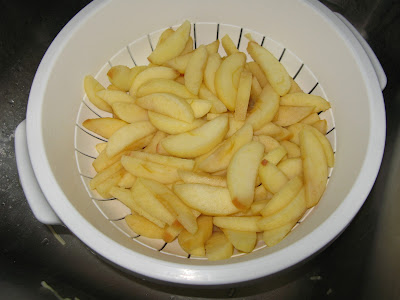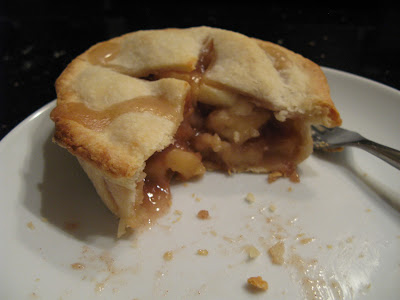-2 cups of all-purpose flour
-1 cup of cold butter (salted or unsalted)
-9.5 tbsp of ice cold water
-Egg white or an egg to close the edges
The dough isn't as flaky as I'd like to be but it was easy to work with. No cracks on the edge when I roll the dough, which I thought was a good thing. 9.5 tablespoons of water seems a lot but the crust was never soggy. Everyone that tried my pies never had any complaints about the crust. Some just didn't like the fillings.
I came across this site which explains about behaviors between the main ingredients for a pie crust. The key point from this article is that if you combine flour with butter without water, it'll form a paste which acts as fat. More flour is then added followed by water to form gluten layers. Fat creates the void space between gluten layers when baked. By having more void space, the pie has more flakiness. The recipe can be found here, however, I used a modified recipe as I generally prefer a lighter crust and I was making four apple pot pies instead of a 9-inch pie. The ratios are similar to the author's (Kenji Lopez) though:
-2 cups of all-purpose flour
-1 cup of cold unsalted butter
-1.5 tbsp of sugar
-3/4 tsp of salt
-5 tbsp of water
-1 egg for closing the edges
For the filling, I used:
-8 organic Gala apples
-1/2 cup of sugar
-1 tsp of cinnamon
-1/4 cup of all-purpose flour
And so begins my first time using a food processor, which I borrowed from a friend! I followed the same techniques as Kenji's, processing flour with butter without water. However, with the same number of pulses, it came out powdery rather than pasty.
After adding more flour and water to the mixture, I was able to form a ball with my hands, although I shouldn't be doing that as using my hands could melt the butter and thus, creating crust without void space. I left the dough in the fridge for a day before rolling it and this is how it came out.
Apples were prepared and added to the pot pans.
I froze three of them and baked one at 400°F for thirty minutes.
Not the best looking pie I've made to date but my biggest disappointment was the fact that the crust didn't come out flaky. It was a bit runny as well and the sides collapsed after pressing it.
I baked one of the frozen pies the following day only this time, it was set to 425°F for the first twenty minutes and then 375°F for the last twenty minutes.
The taste however, was very heavy on the crust. So heavy that it took some of the sweetness away. And again, the crust wasn't flaky; it was more crumbly.
The following night, I baked my third pie from the batch at 450°F for the first twenty minutes and then 375°F for the last twenty minutes.
The results are similar to my first pie but the rim and bottom crust are crispier which makes the pie darker. It was also very runny.
And finally, for my last pie of the week, I baked it at 425°F for the first twenty minutes and then 375°F for the last twenty minutes.
It came out pretty well. The crust was a little bit thicker but not as thick as my second one. Not too runny, the crust was able to hold most of the juice inside. Despite a thicker crust, the sweetness was still there. This is my favorite pie from this batch.
The fact that I wasn't able to achieve a flaky crust is because I wasn't able to get that flour and butter paste. It came out powdery instead, and as a result, the crust was crumbly. I was worried that the butter would melt when I mixed it with flour.
Despite not being able to get the perfect crust this week, there were a few things that we can learn from this:
- Baking at a higher temperature for the first half of the process will harden the crust. Temperature must be lowered in
- For a frozen apple pot pie, baking at 425°F for the first twenty minutes and then 375°F for the last twenty minutes seem to be the threshold before the pie goes runny.
- Thicker crust helps the pie retain the juice as well but very thick crust will take the sweetness away from the pie.
For my next batch, I'll keep pulsing the flour and butter mixture until it forms a paste whether the butter melts or not. Hopefully not.












No comments:
Post a Comment